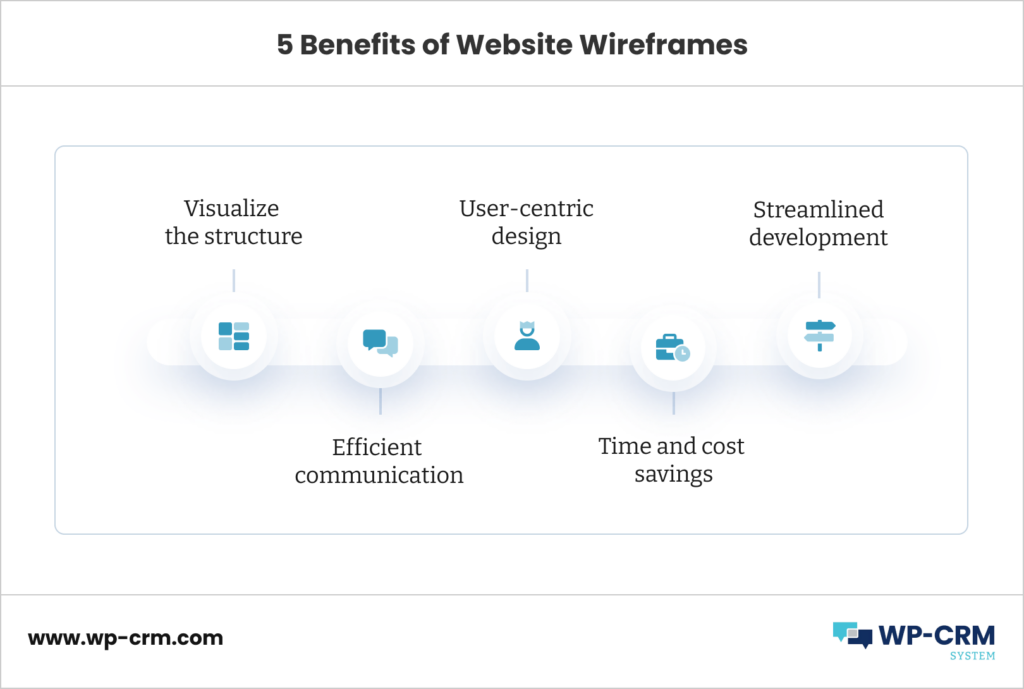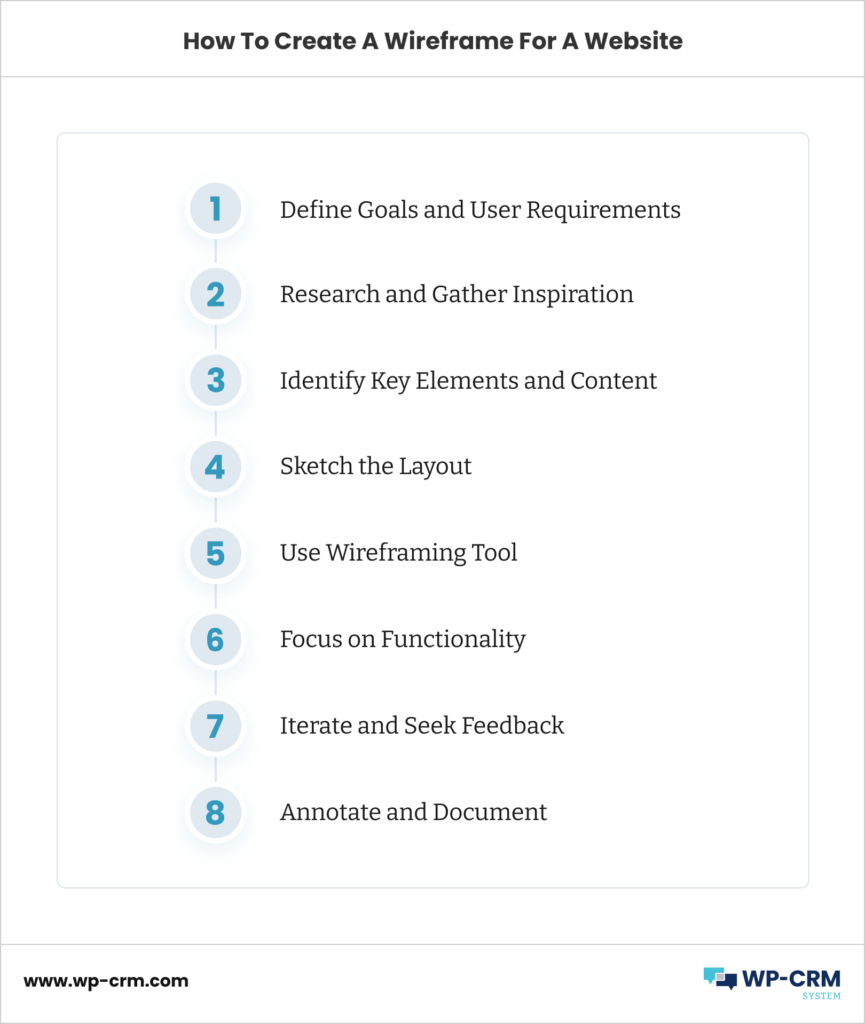What Is A Website Wireframe: Everything You Need To Know
No matter how excited you are to dive into your new project, in website design and development, as well as in business analysis, preparation is fundamental. Therefore, it is essential to create a mock-up version of the architecture before the actual production. And this brings us to our current topic: what is a website wireframe?
Simply put, a website wireframe is a sketch of what your (or your client’s) website would look like, how the different features are going to be structured and what user flows are going to develop. Building a mockup is an iterative process; in fact, its purpose is to be constantly changed and improved.
In this article, we will cover in more detail what a website wireframe consists of, its benefits, the steps to build one successfully, and some tools to help you out. Let’s get into it!
What Is A Website Wireframe?
A website wireframe is a practical map of the main elements and navigation of a new website design. It helps team members better understand where everything will fall into place, determine what their individual part of the puzzle is and how it affects the overall layout, navigation, and user experience.
The process of building a website wireframe may be tiring and time-consuming but not in any case unnecessary. As a matter of fact, a lack of proper planning would take more time and may even cost you the project!

So, make sure you get it going in the early development stages to uncover errors and potential navigation problems before you have the code wrapped up and have chosen the color scheme and even the fonts.
Your initial wireframe does not have to be that detailed. It is a good idea to start with a text-format sketch beforehand to map out possible steps of the end user and ways to reduce the number of clicks to achieve a conversion.Then, continue with a low-fidelity wireframe to plan how the specific design elements will spread on the screen. Then, develop them in high-fidelity wireframes and finish off their final look.
Why Build A Website Wireframe: Benefits
As we explained, a website wireframe is a visual representation that outlines the structure, layout, and functionality of a website before any design elements or content are added. Here are some key benefits of creating a website wireframe:

- Visualize the structure. A wireframe allows designers and clients to visualize the skeletal framework of a website. It defines the placement of key elements such as navigation menus, content sections, and call-to-action buttons. By establishing the overall structure, designers can ensure an organized and intuitive user experience.
- Efficient communication. Wireframes act as a communication tool between designers, clients, and developers. They provide a clear and concise representation of the website’s layout and functionality, helping all stakeholders align their vision and expectations. This early-stage visualization helps identify and address potential issues or misunderstandings before investing time and resources into development.
- User-centric design. Wireframes enable designers to focus on user experience (UX) and usability aspects of a website. By mapping out user flows and interactions, designers can identify and resolve any potential usability problems early on. This user-centric approach leads to a more intuitive and engaging final product, ultimately enhancing user satisfaction.
- Time and cost savings. Creating a wireframe allows designers to iterate and refine the website’s structure and functionality without investing significant resources. By identifying and rectifying design flaws and usability issues in the wireframe stage, developers can avoid costly and time-consuming revisions during the later stages of development.
- Streamlined development. A well-defined wireframe provides developers with a clear roadmap for building the website. It helps them understand the required features, functionality, and content placement, ensuring a more efficient development process. This streamlined approach reduces the likelihood of misinterpretation and rework, resulting in faster delivery times.
How To Create A Wireframe For A Website

As creating a website wireframe is a process you shouldn’t skip, we broke it down into eight actionable steps.
1. Define Goals and User Requirements
Before starting the wireframing process, it’s crucial to clearly define the goals and user requirements for the website. Understand the target audience, their needs, and the purpose of the website. This information will guide the wireframe creation process and ensure that the resulting design meets the intended objectives.
2. Research and Gather Inspiration
Take the time to research and gather inspiration from other websites or industry trends. Look for websites with similar functionalities or aesthetics to get ideas for the wireframe. This research will help in understanding best practices and design patterns that can be incorporated into the wireframe.
3. Identify Key Elements and Content
Identify the key elements that need to be in the wireframe. This includes navigation menus, headers, footers, content sections, forms, and any other interactive elements. Consider the content that will be present on each page and how it will be organized and presented to the user.
4. Sketch the Layout

Begin by sketching a rough layout of the website on paper or using a digital sketching tool. Focus on creating a basic structure that represents the placement and hierarchy of the elements identified in the previous step. Start with the homepage and then move on to other important pages.
5. Use Wireframing Tool
Once the initial sketch is complete, transition to using wireframing tools to create a more refined and digital version of the wireframe. There are several wireframing tools available, such as Adobe XD, Sketch, Balsamiq, or Figma. These tools provide pre-built UI components and templates that can be used to create a more polished wireframe.
6. Focus on Functionality
When creating the wireframe, emphasize the functionality and user flow rather than visual aesthetics. The wireframe should represent the structure, layout, and interactions of the website. Use simple and recognizable symbols or placeholders to represent images, text, buttons, and other elements.
7. Iterate and Seek Feedback
Once the wireframe is created, iterate and refine it based on feedback from stakeholders, including clients, designers, and developers. Share the wireframe with them and gather their input to identify areas that need improvement or adjustment. This iterative process will help in creating a wireframe that aligns with the project requirements.
8. Annotate and Document
Add annotations and notes to the wireframe to provide additional context and details for the design and functionality. This documentation will serve as a reference for the development team and ensure that the final product accurately reflects the wireframe’s intended design and features.
Winding Up
As you can see, creating a website wireframe is quite important for the success of your website. By following the steps we’ve outlined above, you can map out all important aspects of your new website design and make your team and the clients happy. Need some help managing your communication with clients? Stay on top of the game – install WP-CRM today, or contact us for more details.
